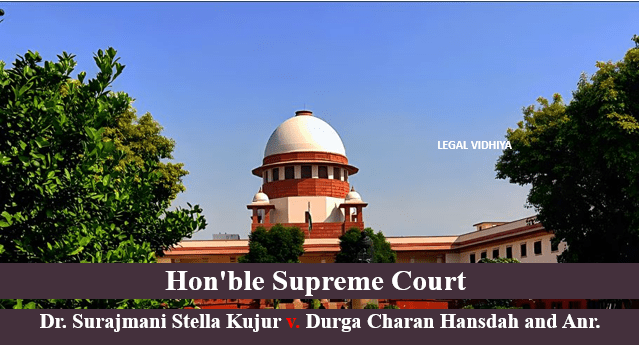
| Case Name: | Dr. Surajmani Stella Kujur v. Durga Charan Hansdah and Anr. |
| Citation: | AIR 2001 SC 938 |
| Case Type: | Special Leave Petition |
| Case Number: | Appeal (crl.) 186 of 2001Special Leave Petition (crl.) 2436 of 2000 |
| Date of Judgement: | 14th February 2001 |
| Court: | Supreme Court of India |
| Petitioner: | Dr. Surajmani Stella Kujur |
| Respondent: | Durga Charan Hansdah and Anr. |
| Bench: | K.T. Thomas, R.P. Sethi |
| Keywords: | PolygamyHinduScheduled Castes Scheduled Tribes |
| Referred: | Section 2 of the Hindu Marriage Act, 1955Section 494 of the IPC |
FACTS:
- In this case, the husband and wife both belong to a tribal community.
- The respondent married again during the lifetime of his first marriage. Both individuals claim to practice Hinduism.
- The wife lodged a complaint against the husband for polygamy, and pleaded that the husband should be held liable under Section 494 of the IPC.
- Section 2 of the Hindu Marriage Act, 1955- Application of the Act.
- Article 342- Scheduled Tribes.
- Section 3(a) of the Hindu Marriage Act, 1955- custom and usage.
- Section 494 of the IPC- Marrying again during the lifetime of husband or wife.
ISSUES:
1. Who is a ‘Hindu’ as per the Hindu Marriage Act, 1955?
2. Whether a custom can be considered for the conviction of the appellant?
CONTENTIONS OF THE APPELLANT:
- The appellant did not refer to any custom which is supported by law and that prohibits the solemnization of second marriage.
- The appellant could not give strong evidence to prove that the second marriage of the respondent is void.
- The appellant claims to be a ‘Hindu’ by religion and was unclear on her statements.
JUDGEMENT:
The Court first cleared the question of ‘Who is a Hindu?’ under the Hindu Marriage Act, 1955 and also stated the persons who do not qualify as a ‘Hindu’. The Court also stated the features of ‘Hinduism’ and also mentioned that the social conduct of this religion is very strict under different caste systems and sectors. Particularly Virashaiva, Lingayat, followers of Brahmo, Prarthana or Arya Samaj along with followers of Buddhism, Jainism and Sikh come under the definition of a ‘Hindu’. Muslims, Parsis, Jews and Christians residing within the territory of India are not classified as ‘Hindus’.
Secondly, since the appellant could not produce enough evidences to show the existence of a custom that is ancient, reasonable and abides by the rule of law which proves that the second marriage of the respondent is void, the Court declared that no offence under Section 494 of the IPC will be made against the respondent. However, the Court stated that the appellant is still entitled for maintenance from the respondent as she was still his legally wedded wife.
CONCLUSION
This case highlighted a very important aspect when it comes to filing a complaint. It is very much true that the respondent committed polygamy, since as per the facts of the case the respondent indeed married again during the lifetime of his first wife. However, the wife could not produce enough evidences or any custom or any principle to prove that the respondent was guilty of bigamy. Her appeal was dismissed due to lack of enough proof against the respondent. Marriage is a sacred harmony between two individuals and if one of the spouses commits polygamy, it is obvious that the aggrieved spouse would seek justice.
The appellant’s lack of credibility in her contentions, led to the victory of the respondent. Therefore, it is important to produce proper evidences to establish a strong defense against the other party.
By Sama Amin a student of Amity University, Dubai, 6th Semester, an intern under Legal Vidhiya




0 Comments